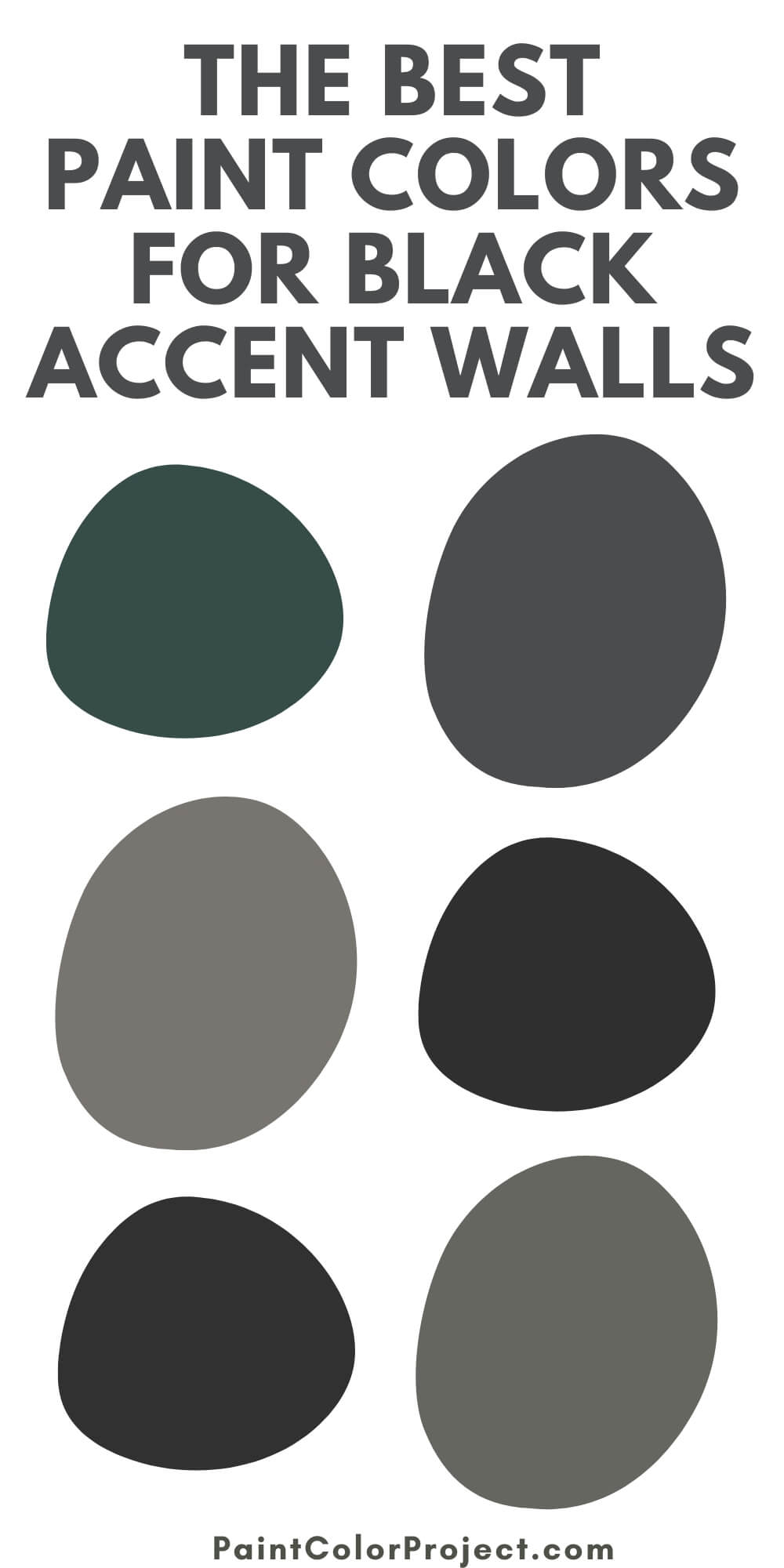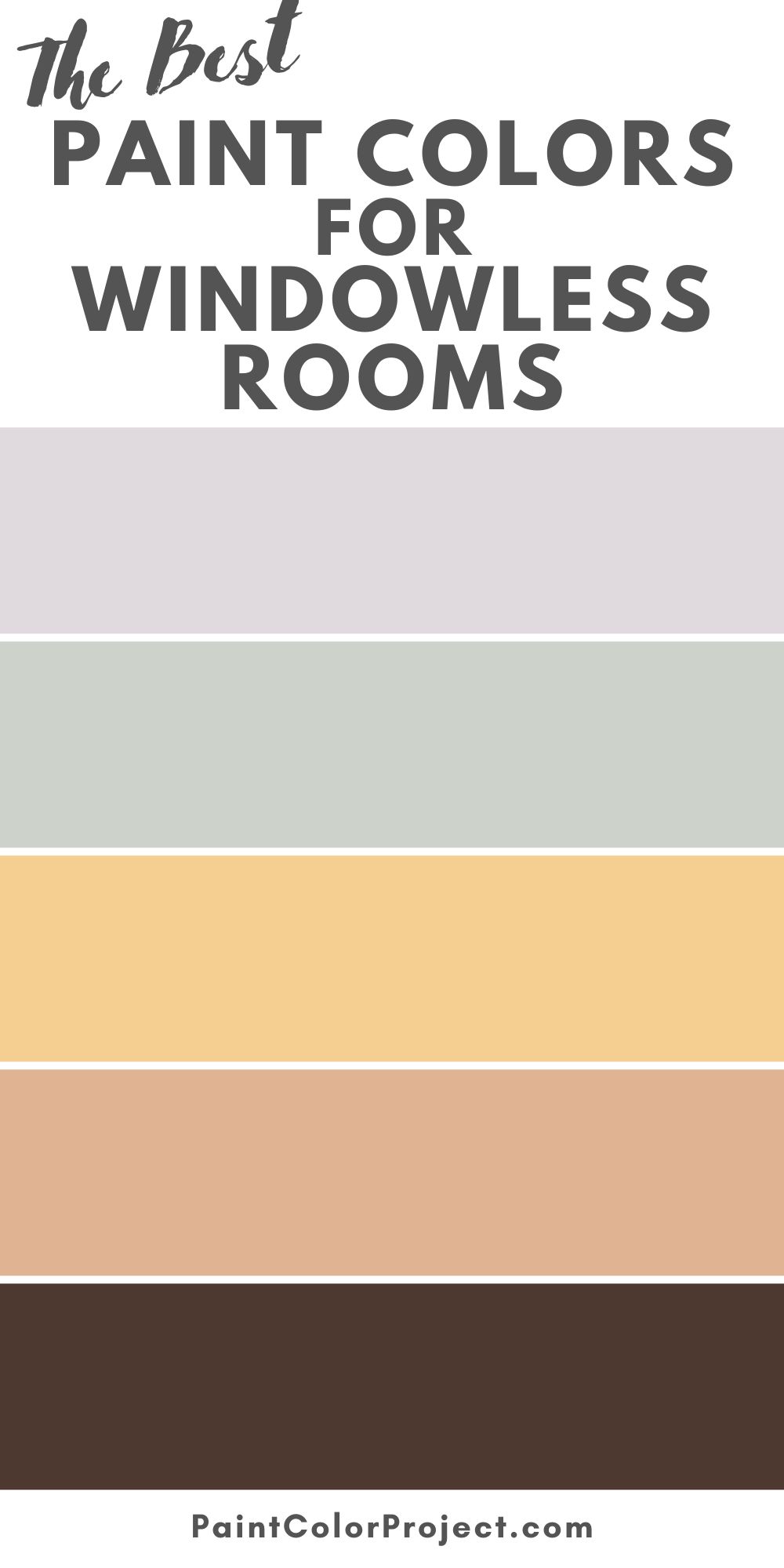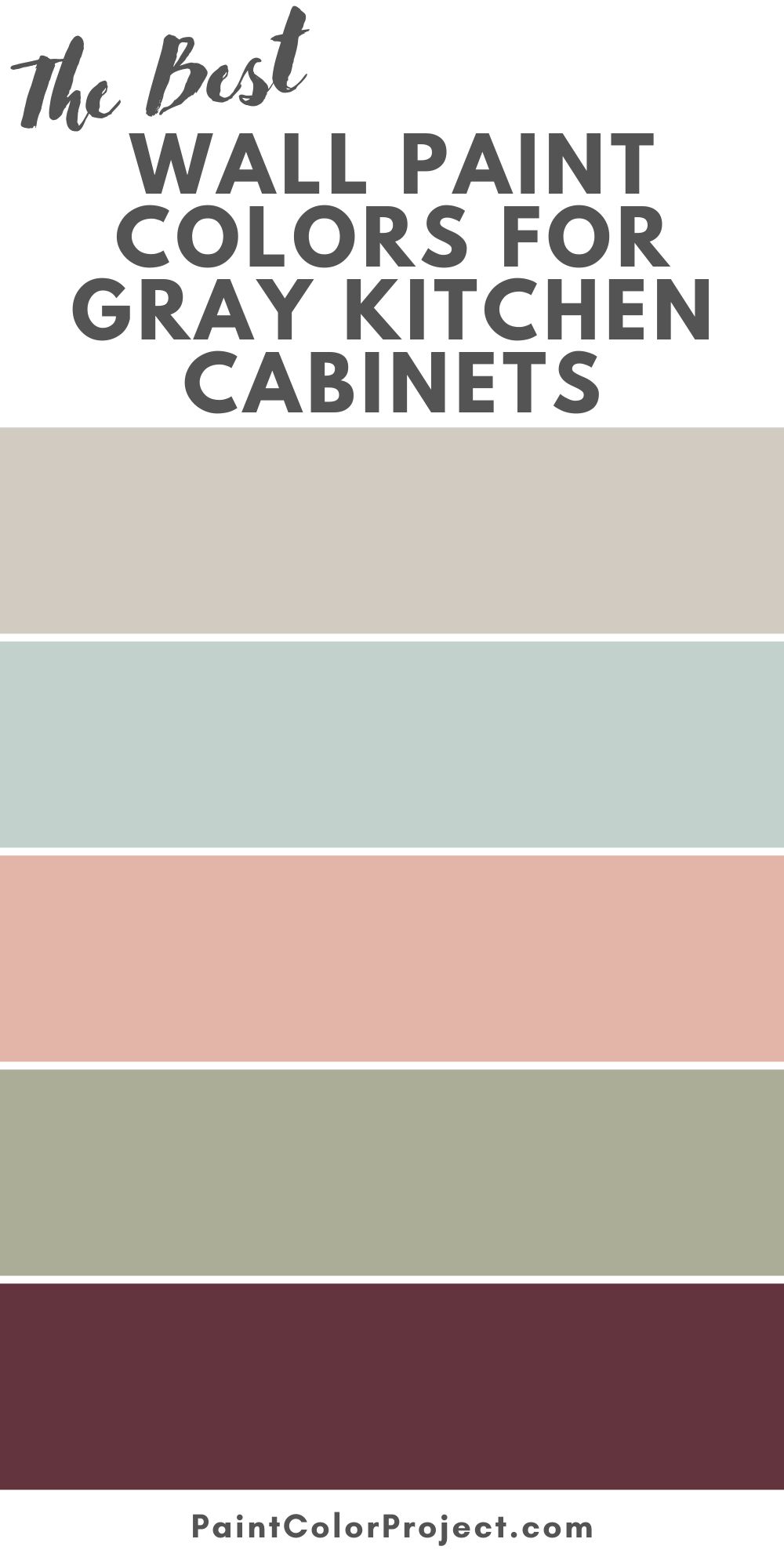Curious about what accent colors go well with light blue walls? We've got a list of amazing color combinations that will bring your space to life!
Whether it’s your bedroom, bathroom, living room, or kitchen, you’ve decided to go with light blue paint colors for your walls.
The good news is that the light shade complements various colors from an interior design lens. Each pairing makes for a distinct aesthetic.
A taupe, coral, or orange pairing makes for a beachy ambiance. Meanwhile, darker shades like teal, black, or red offer a more dramatic appearance to your room.
Stick around to learn more about what accent colors go best with light blue walls.
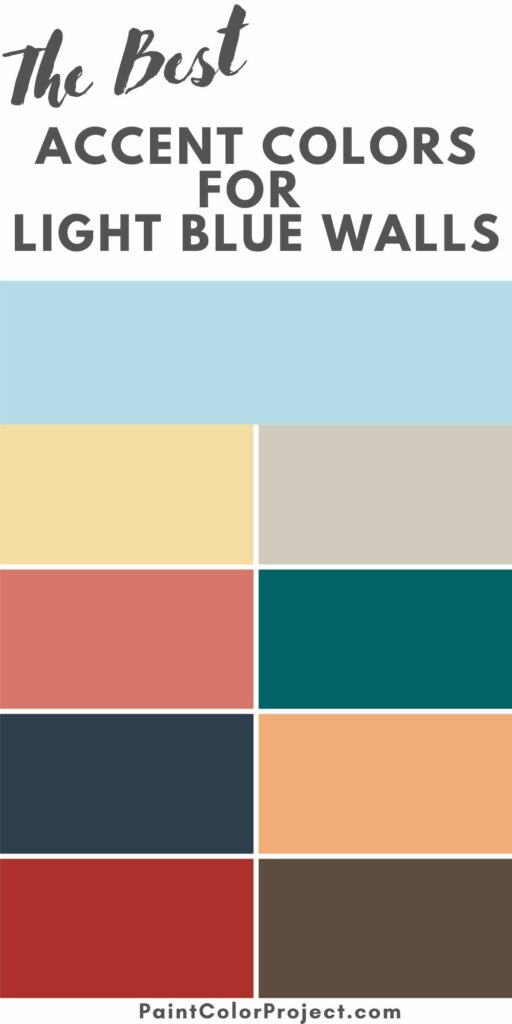
What Accent Colors Go with Light Blue Walls?
The best accent colors to pair with light blue include:
- Light yellow
- Grey
- White
- Peach
- Coral
- Teal
- Blush
- Cream
- Orange
- Mustard
- Cherry
- Black
- Dark Green
- Lime Green
- Navy
- Brown
- Beige
- Taupe
Let’s take a look at each of these color families!
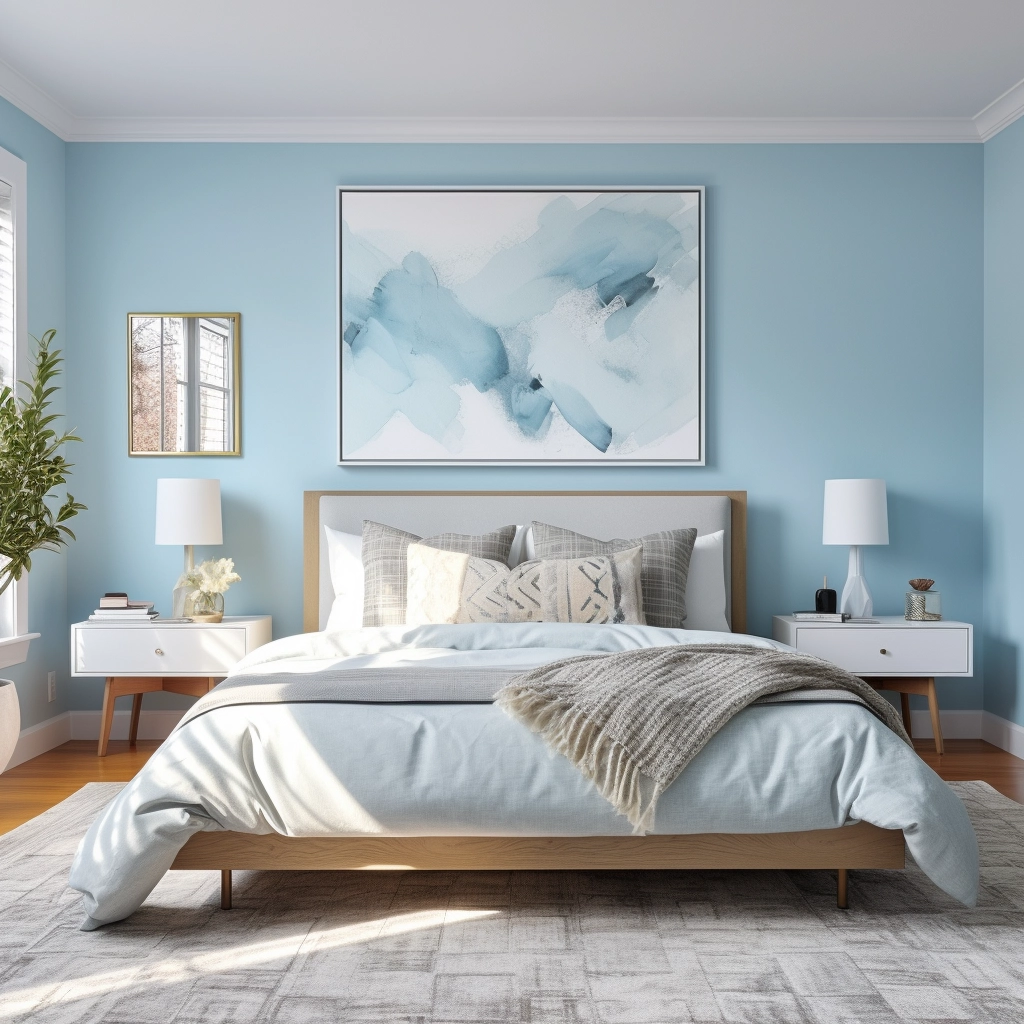
Light Yellow
Yellow and blue are often a classic combination.
Despite yellow being off and on-trend inconsistently, infusing it with a light blue backdrop will offer a timeless appeal.
Light yellow shades offer warmth and brightness to the cold blue.
If you want to avoid an overly vibrant appearance, you can find light yellow shades with gray and brown undertones.
They’ll be muted and give you a more balanced setting.
Depending on the room, you can add light yellow in several areas, including your furniture, decor elements, bedsheets, towels, and pillows.
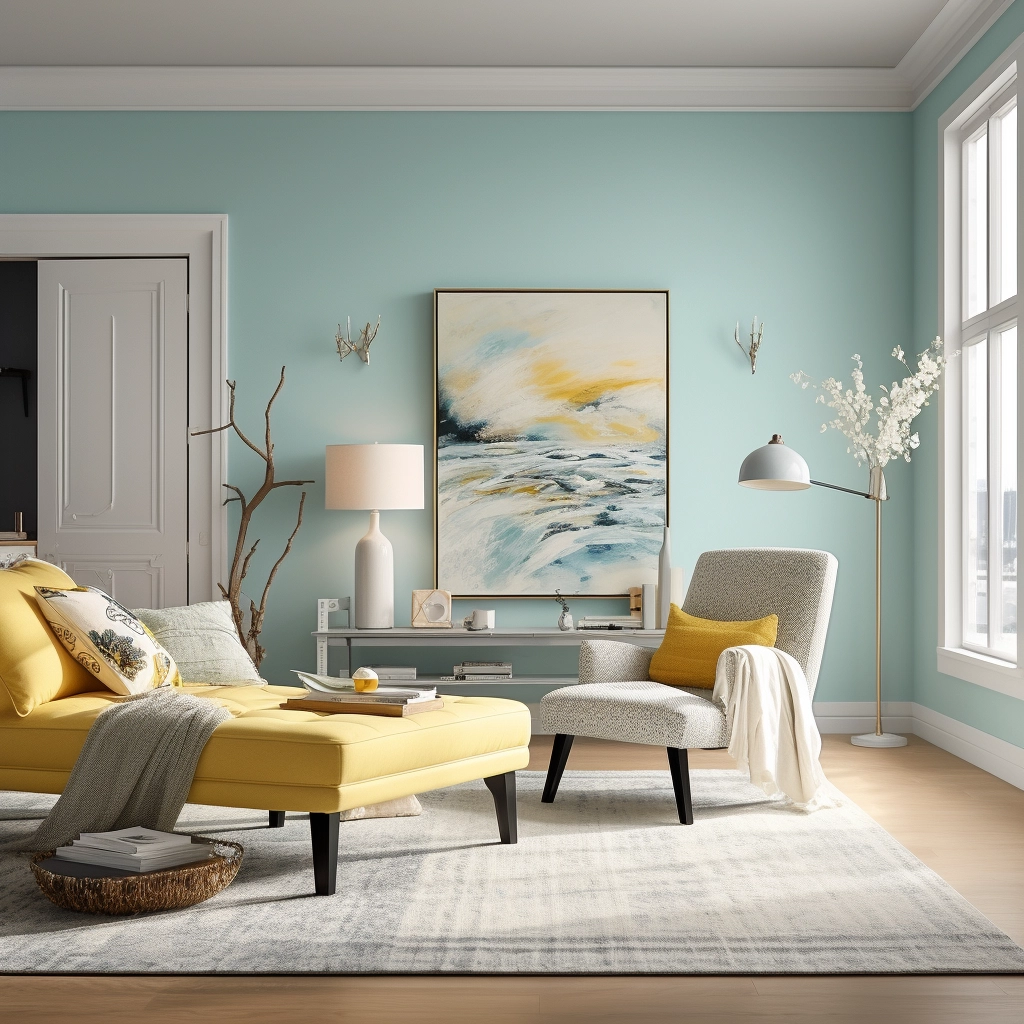
Grey
Grey is the original neutral color. You can’t go wrong with it. Using it will make your light blue walls pop out more.
Its lack of color will give more attention to your light blue walls. You can apply the neutral to your furniture and framed art elements around the house.
One of the best applications, in this case, could be hanging gray curtains.
Plain ones will work cohesively, but if you’re after a bolder look, you can search for patterned options that infuse bolder colors like navy blue or gold.
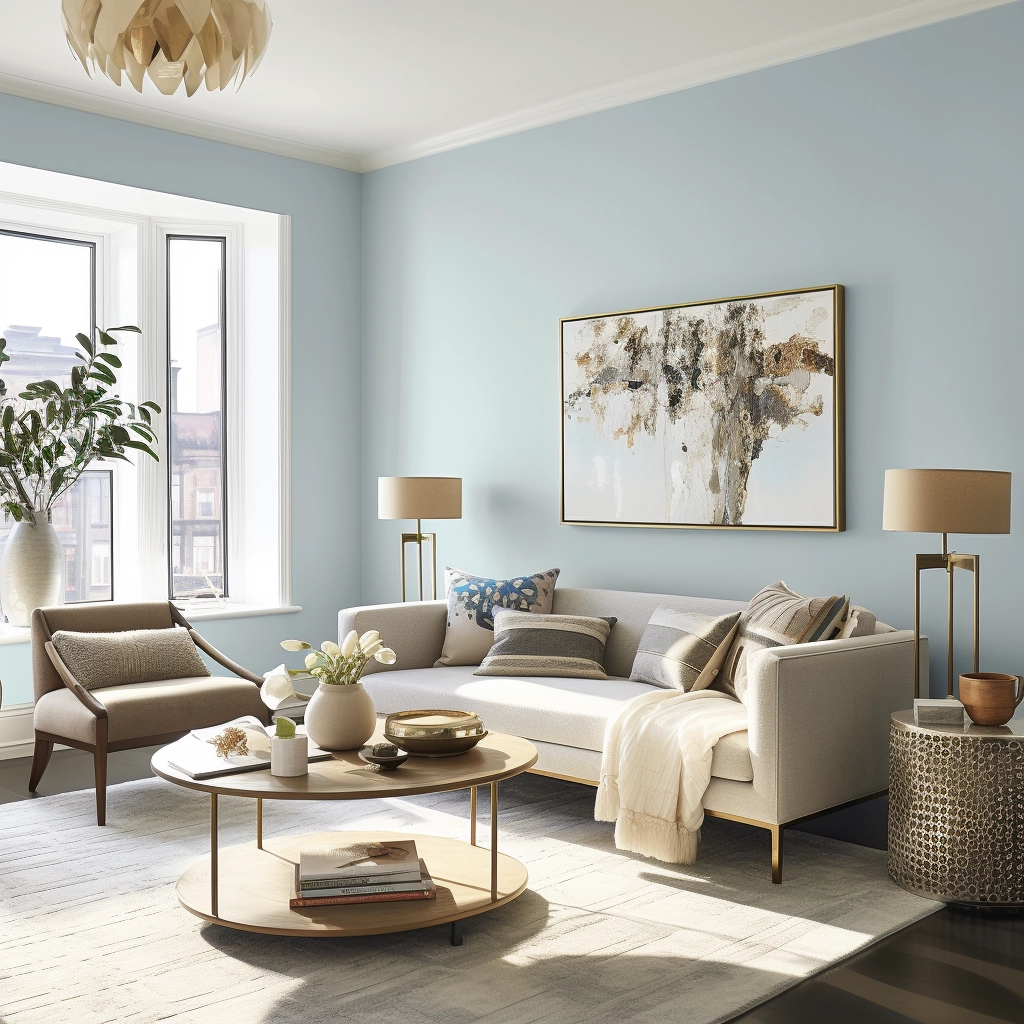
White
Blue and white will give your living space a fresh and calming ambiance.
If you’re painting an accent wall in your light blue-walled room, a white side will brighten the area and make it appear larger.
On the other hand, you can incorporate white in various other elements, from items as small as candles lining your coffee table to a large wall-to-floor bookcase.
Another plus side of using white with light blue is its versatility.
You can add multiple other color scheme options to complement those two shades, like a canary yellow or neutral taupe.
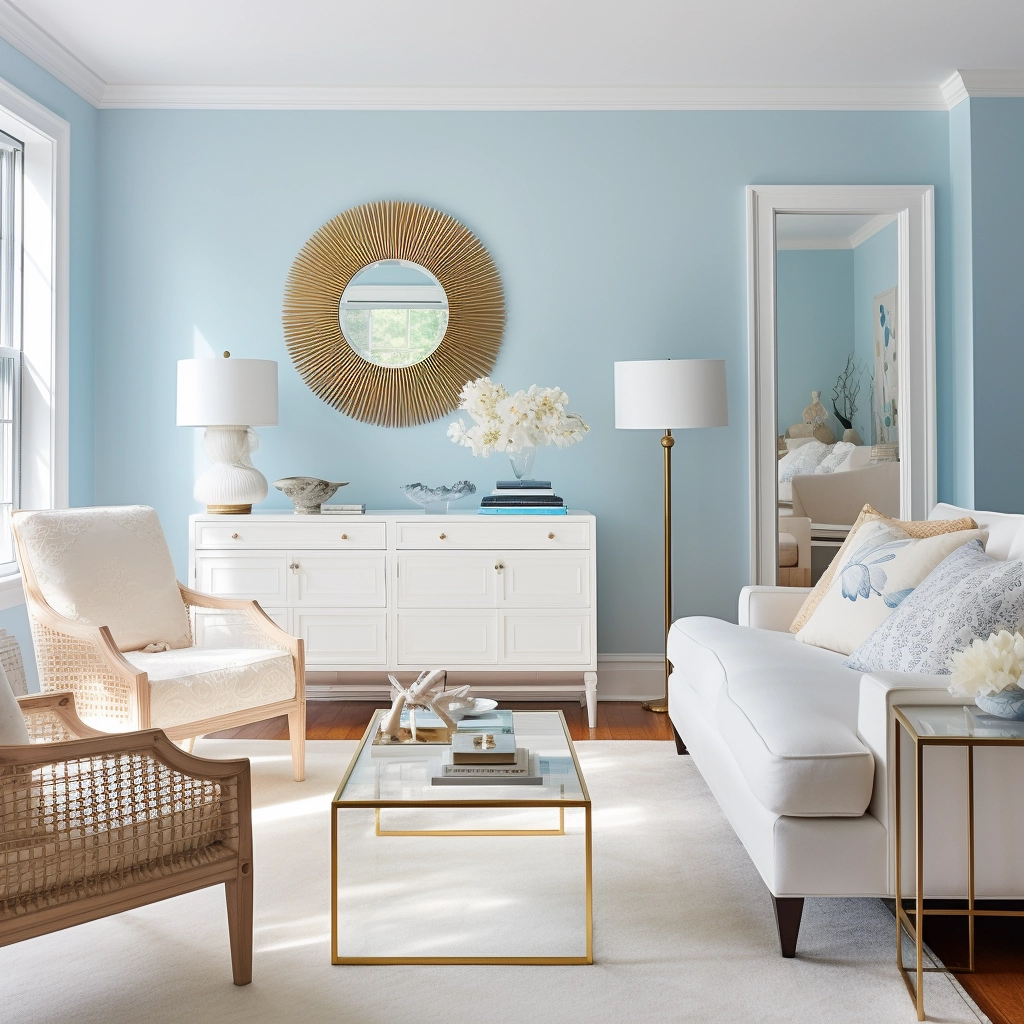
Peach
Your light blue-walled room may feel a little chilly. If that’s the case, you can introduce warmth with peach additions.
The best part is that it’s not as dominating as other warm-toned shades like red or yellow. Instead, it’s subtle and elegant.
You can infuse the complimentary peach shade as an accent wall or add items like peach-colored throw pillows, duvets, and art images.
Adding peach shades to a light blue-walled bedroom will give you a dainty appearance.
Meanwhile, the peach and light blue walls will go exceptionally well with gold or brass metal elements if it's a bathroom.
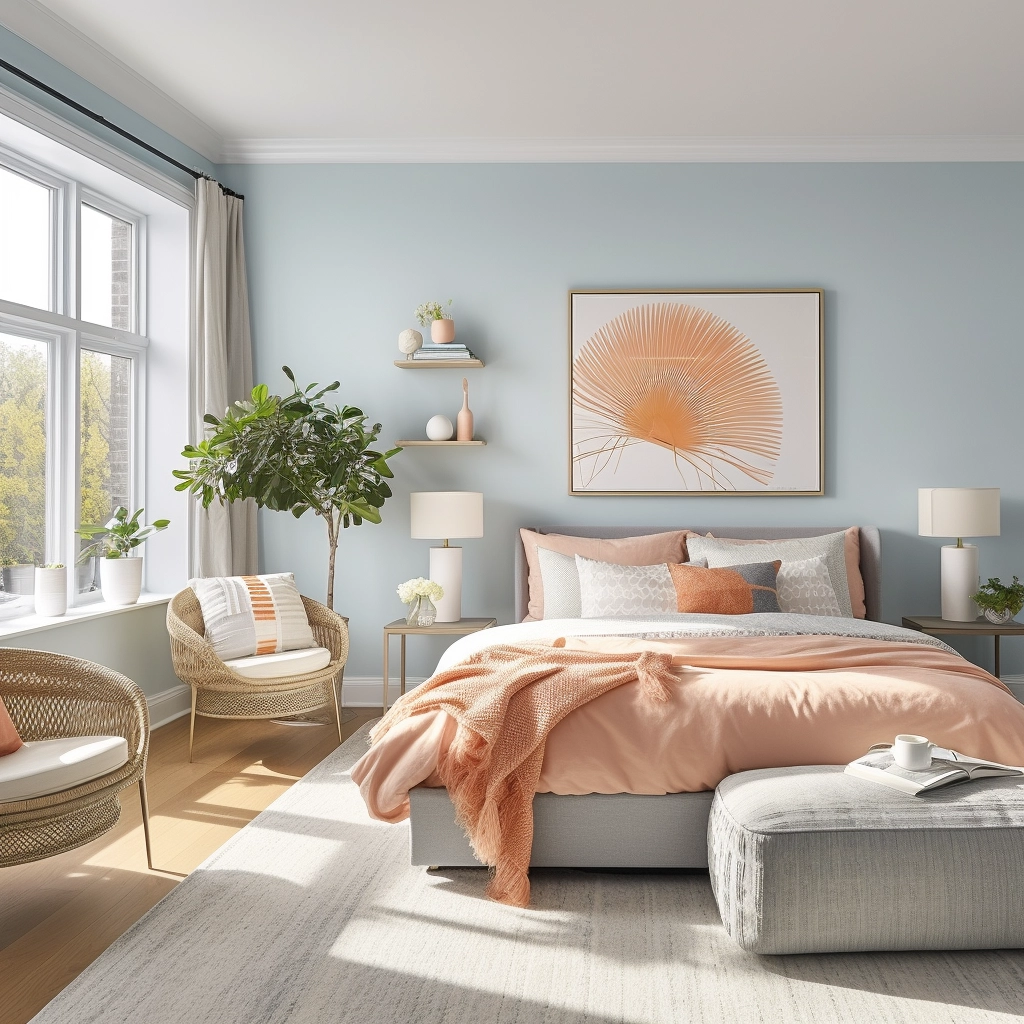
Coral
Coral and peach shades are often confused. The prime difference is that coral is deeper and has pinkish undertones.
Consequently, the color is perfect if you’re after a bolder and richer combination with your light blue walls.
The color duo will almost resemble a tropical theme, but it won’t be too garish.
You can keep it minimal by adding subtle coral items in the room, like the couch pillows.
Alternatively, if you want to see more of the warm color, you can add a coral rug. Rather than get it plain-colored, you can find rug options with white patterns.
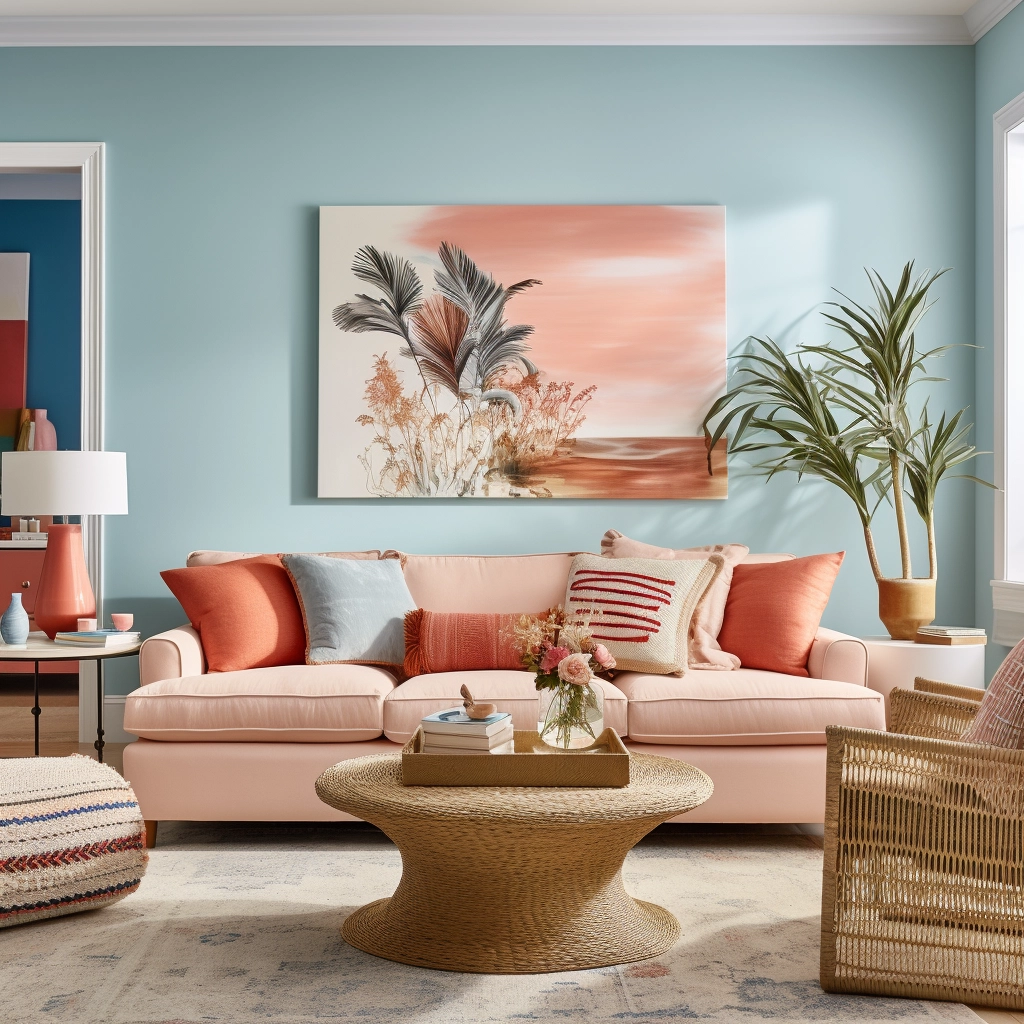
Teal
Adding teal to light blue, especially one with blue undertones, can create the ideal monochromatic atmosphere.
The dark shade will add more depth and contrast to the room.
Teal elements like furniture, blankets, pillows, rugs, or curtains can achieve that effect.
Adding gold or copper accents to those shades will elevate the room and give you elegant results.
These colors are calming, making them the best duo for bedrooms or bathrooms.
Alternatively, you can paint one wall teal to create a dramatic finish. It’ll bring the light blue to life and appear more sophisticated.
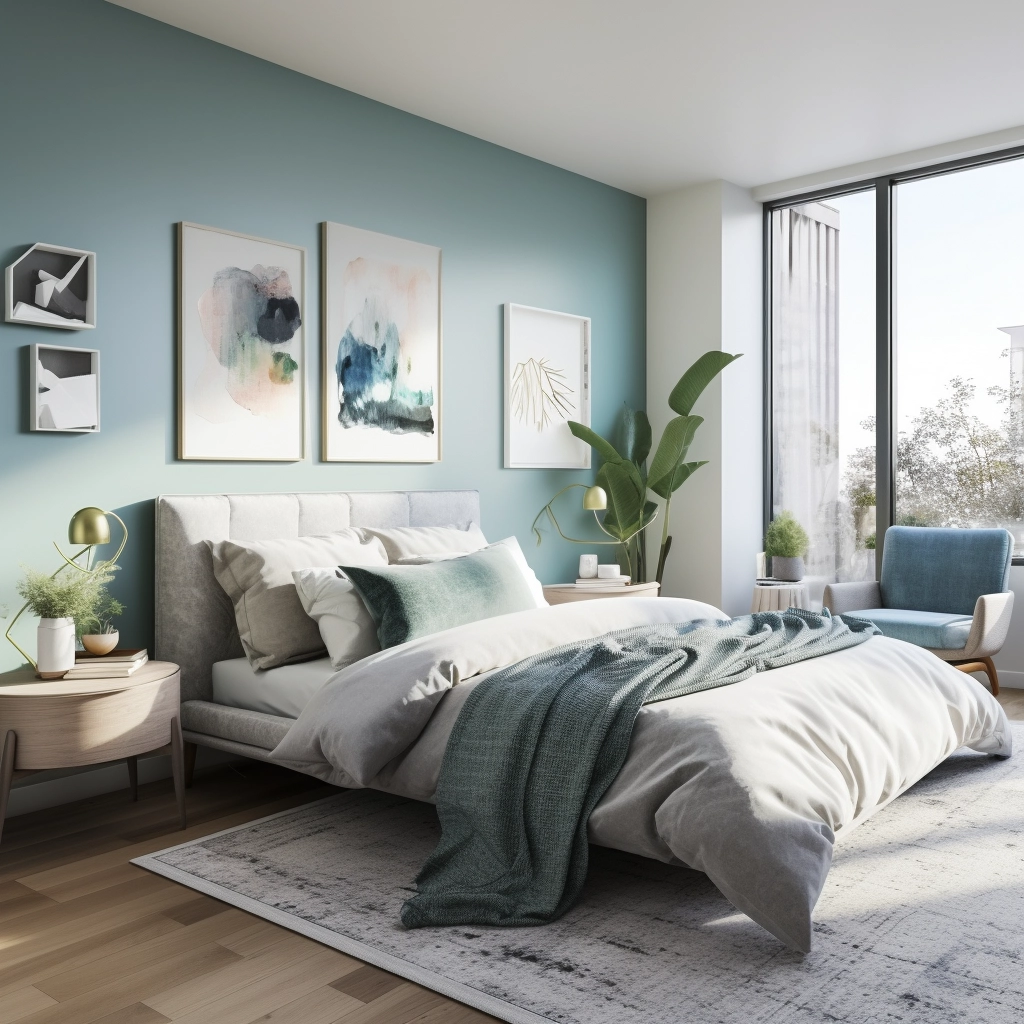
Blush Pink
A blush pink with light blue is a match made in heaven for baby rooms.
The light shades evoke a sense of innocence, purity, and calmness. Both contrasting shades will brighten the room.
If you want to add the combination to your living room, we suggest sticking to a light pink with yellow undertones.
You can make the blush pink addition more subtle by adding natural elements.
For instance, a bouquet of rosy flowers in your dining area or living space will suitably complement the bright blue backdrop.
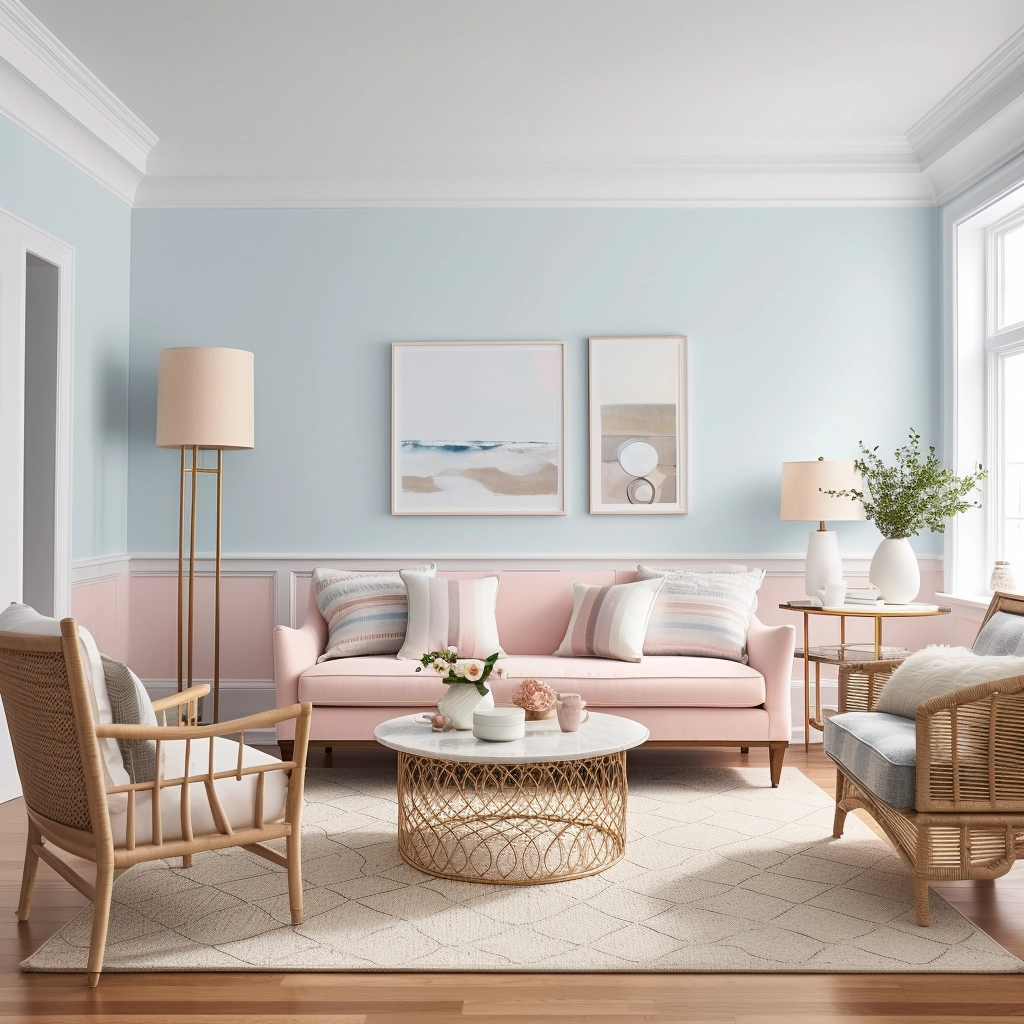
Cream
Cream and light blue shades give off a beachy aesthetic.
The combination would be perfect with textured elements like rattan furniture or red clay vases.
Besides that, like gray, cream is also a neutral shade that’ll bring out the vibrancy of the light blue walls.
If you’re going for a minimalist appeal, the muted shade is the perfect option.
You can add interior elements like cream-colored plush couches, chairs, curtains, and rugs.
It may all appear a bit too bland, so you can incorporate additional bold colors like gold or dark brown.
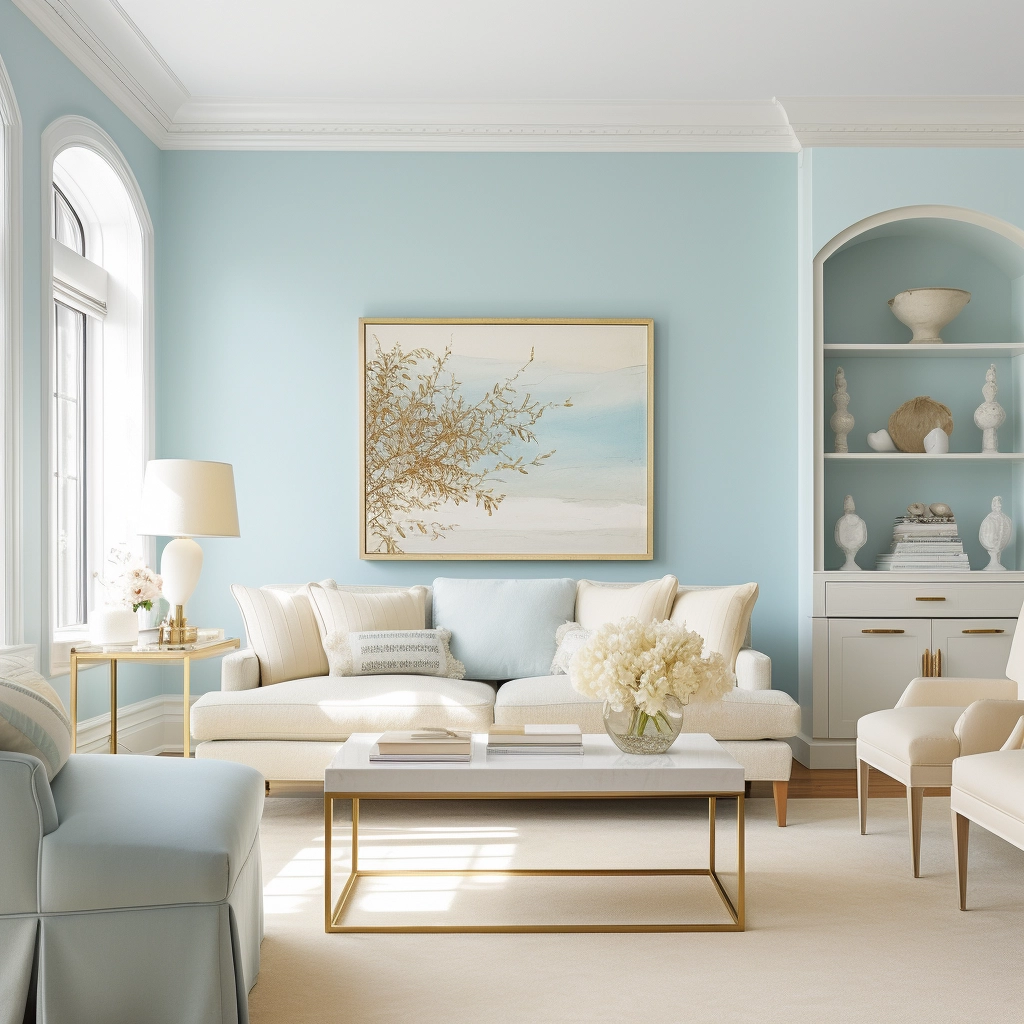
Orange
When referring to orange, we’re not talking about the overly bright tangerine shades.
Instead, think of muted hues with brownish undertones like burnt orange, sienna, rust, or marigold.
These shades will complement your light blue walls since they integrate warmth. This duo choice isn’t for everyone since two bright colors may appear too much.
But the orange addition doesn’t have to be an accent wall. It can come in subtle infusions like patterns in rugs, curtains, bedsheets, or pillows.
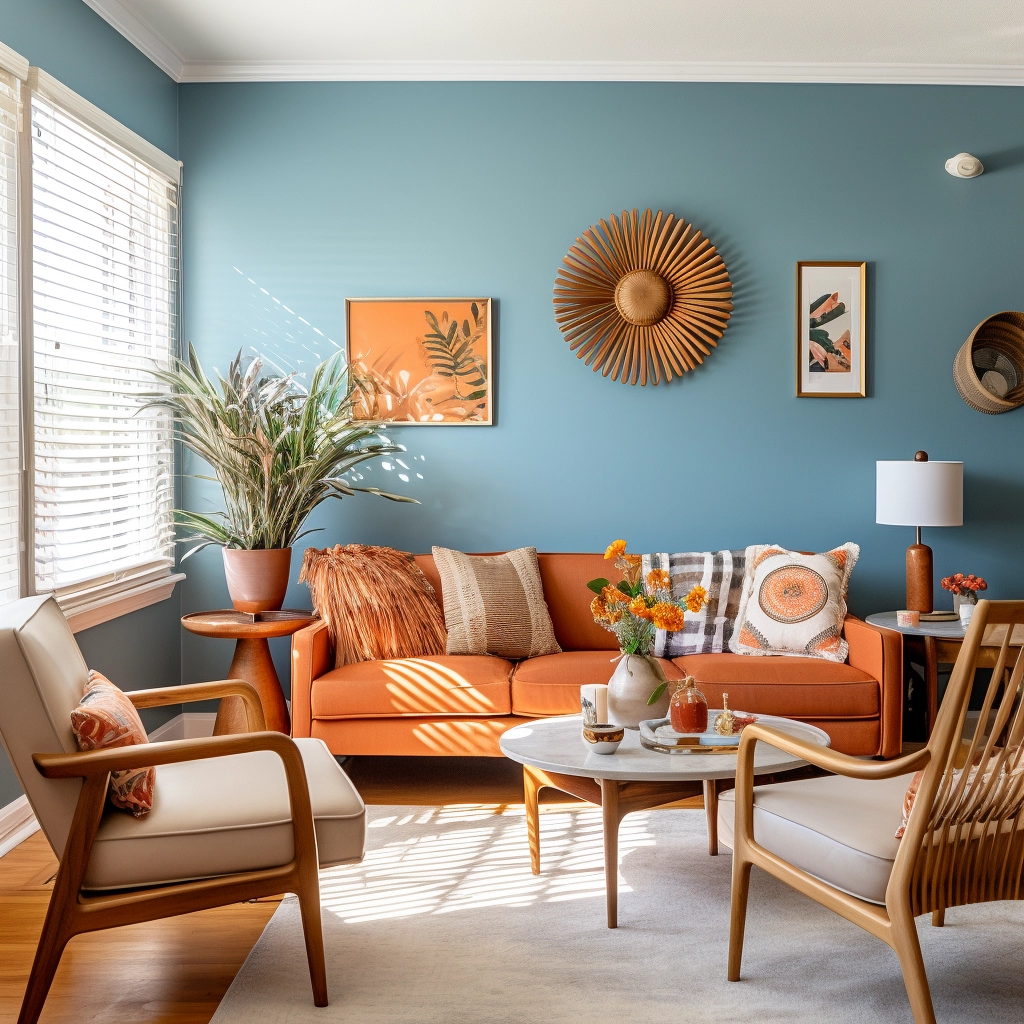
Mustard Yellow
Even though mustard yellow is often paired with an equally dark blue, it can still work with its light counterpart.
The darker shade of yellow will add warmth and depth to the room.
We recommend adding low-key mustard yellow elements in the room to prevent it from overpowering the dainty light blue shade.
For example, you can add it through subtle hints in framed art images.
Now, if you want to go for that bold appeal, incorporate the mustard yellow into larger items, like your furniture.
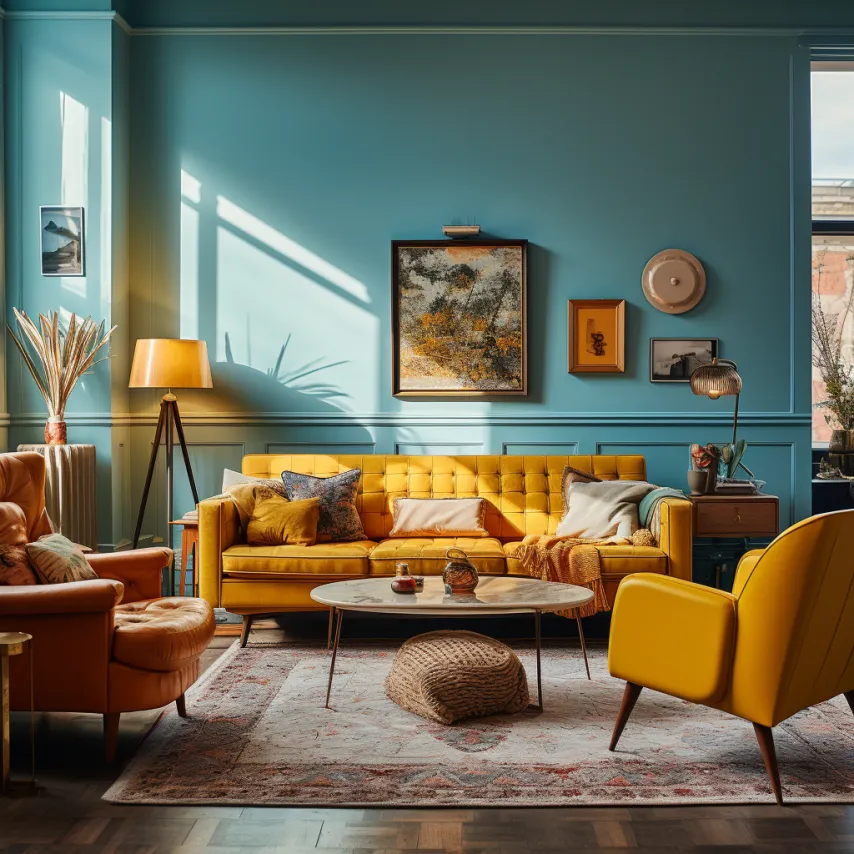
Cherry Red
Cherry red is a brave color pairing choice for your light blue walls.
You might walk into the bright room thinking it needs a more stimulating appearance. That’s where the vivid red shade comes in to spice things up.
As a powerful color, you might not want it to dominate the entire room.
For this reason, you can incorporate it softly in areas like a plant pot, framed image, or a pattern over a rug or curtain.
You can also add natural elements like a red flower bouquet. An ideal houseplant, in this case, would be a cherry red painter’s palette plant.
Overall, the bold shade will bring a strong contrast and effectively complement the light blue background.
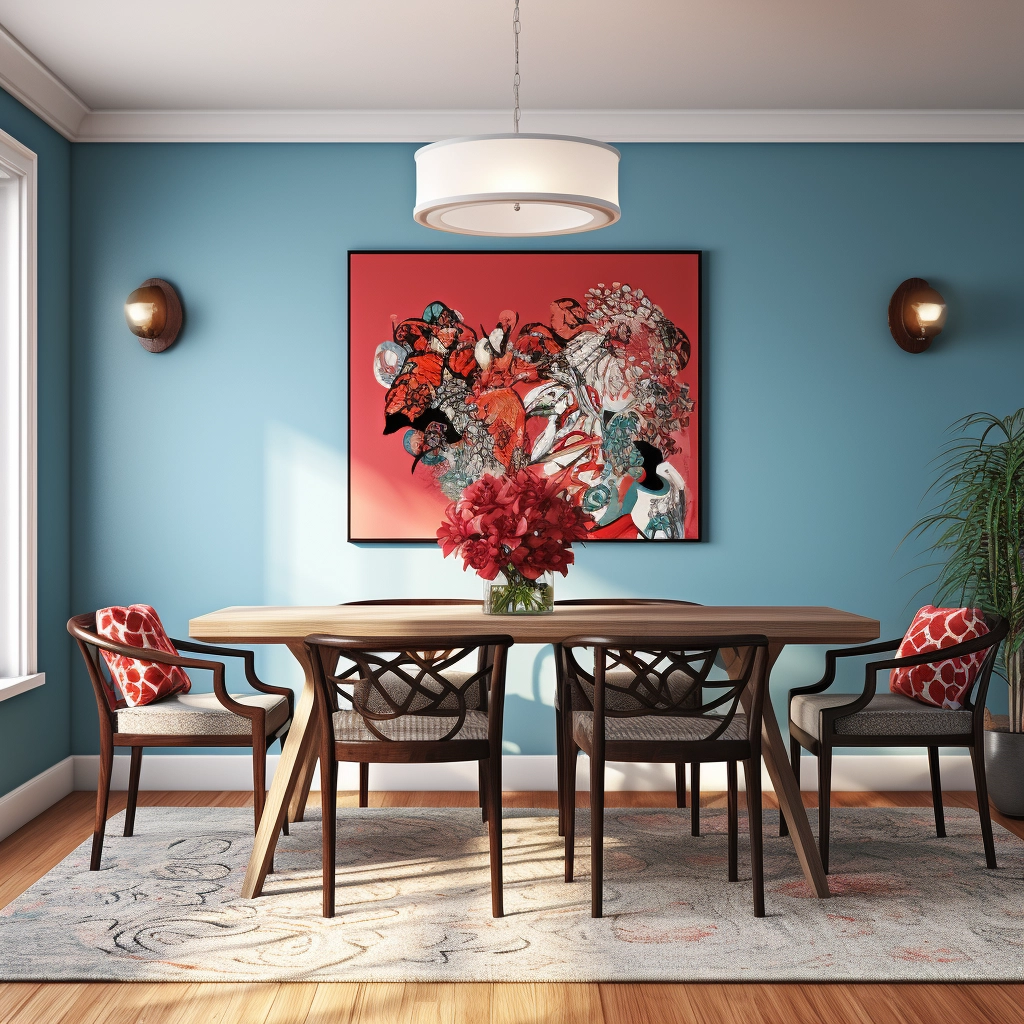
Black
Black accents combined with light blue walls offer a perfect pair for a contemporary interior design setting.
The sharp dark contrast of the dark shade will bring out the sky blue backdrop.
As color theory goes, black goes well with all colors to create distinct designs.
You can add black furniture, curtains, vases, photo frames, light fixtures, carpets, and other home accessories.
Other than that, black boasts sophistication, depth, and drama. It gives the room more edge and design-forward appeal.
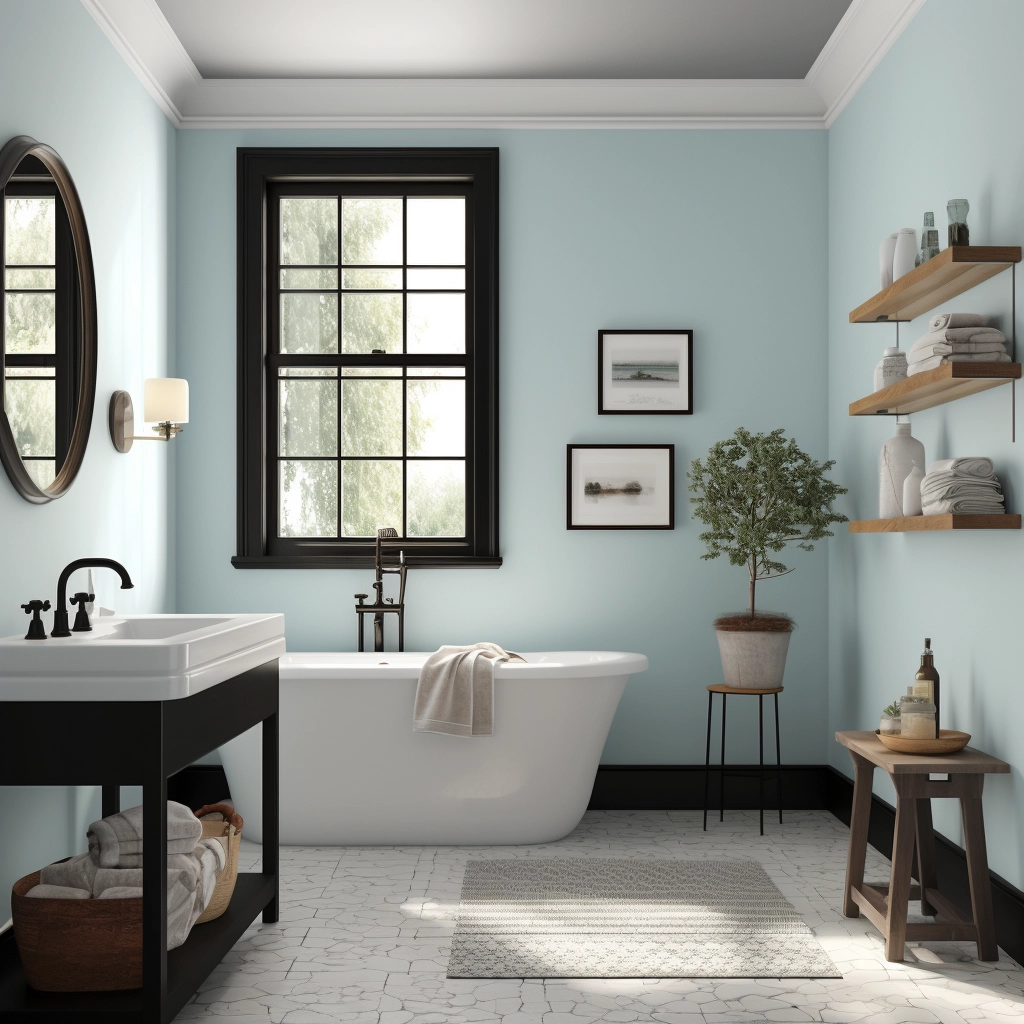
Dark Green
Dark green and light blue will create a harmonious pairing perfect for any room in the house.
Since green comes from blue, it complements the shade. The result is a deep contrast between the dark and light hues.
In terms of what dark green elements you can add, curtains, rugs, pillows, and art frames work exceptionally well.
Alternatively, you can go natural and perch a few houseplants around your home for a fresh and eco-conscious interior design.
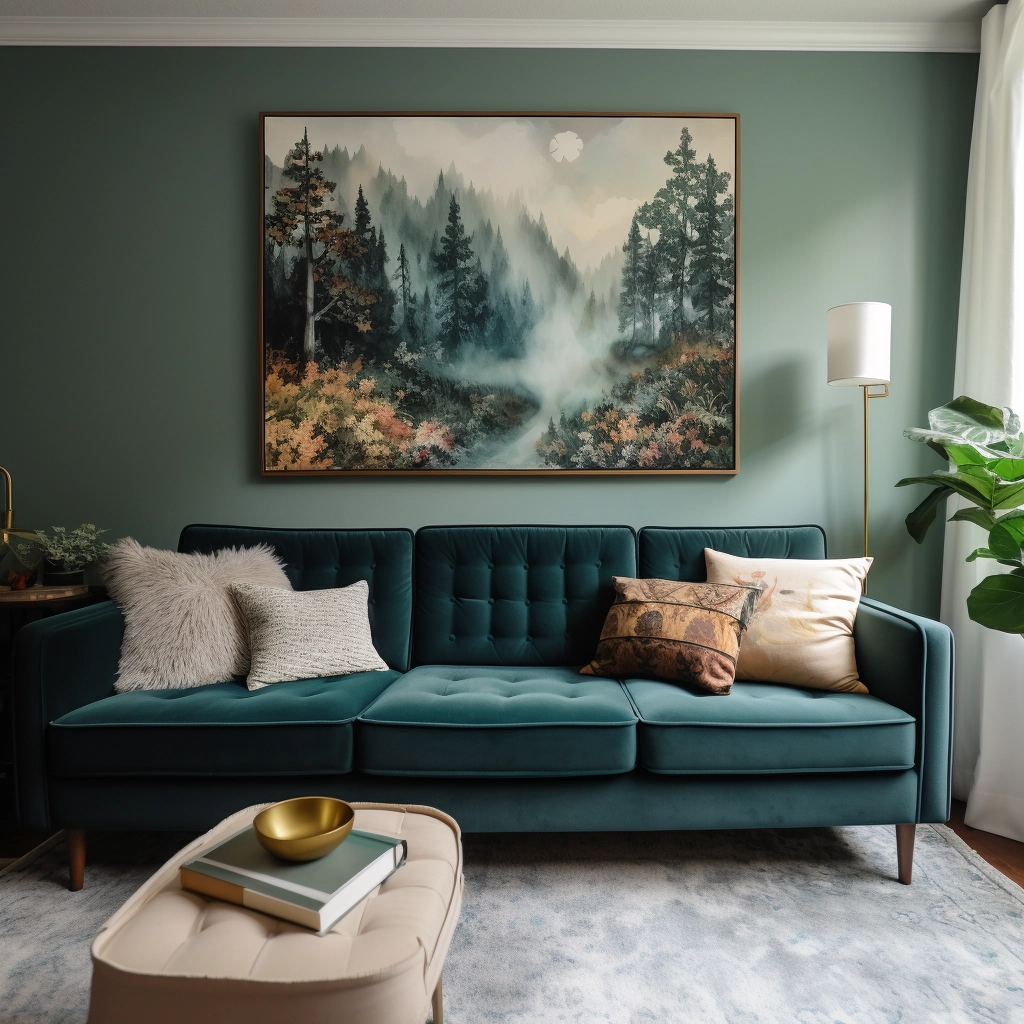
Lime Green
Lime green and light blue is a fun color combination. In interior decor, it often works best in a child’s bedroom or bathroom.
Otherwise, it is a fantastic color palette if you prefer a maximalist or even an almost tropical home decor style.
If you do choose to add it to your main living space, we recommend adding subtle hints of vibrant color. That can include throwing pillows or patterns in your curtain and rug.
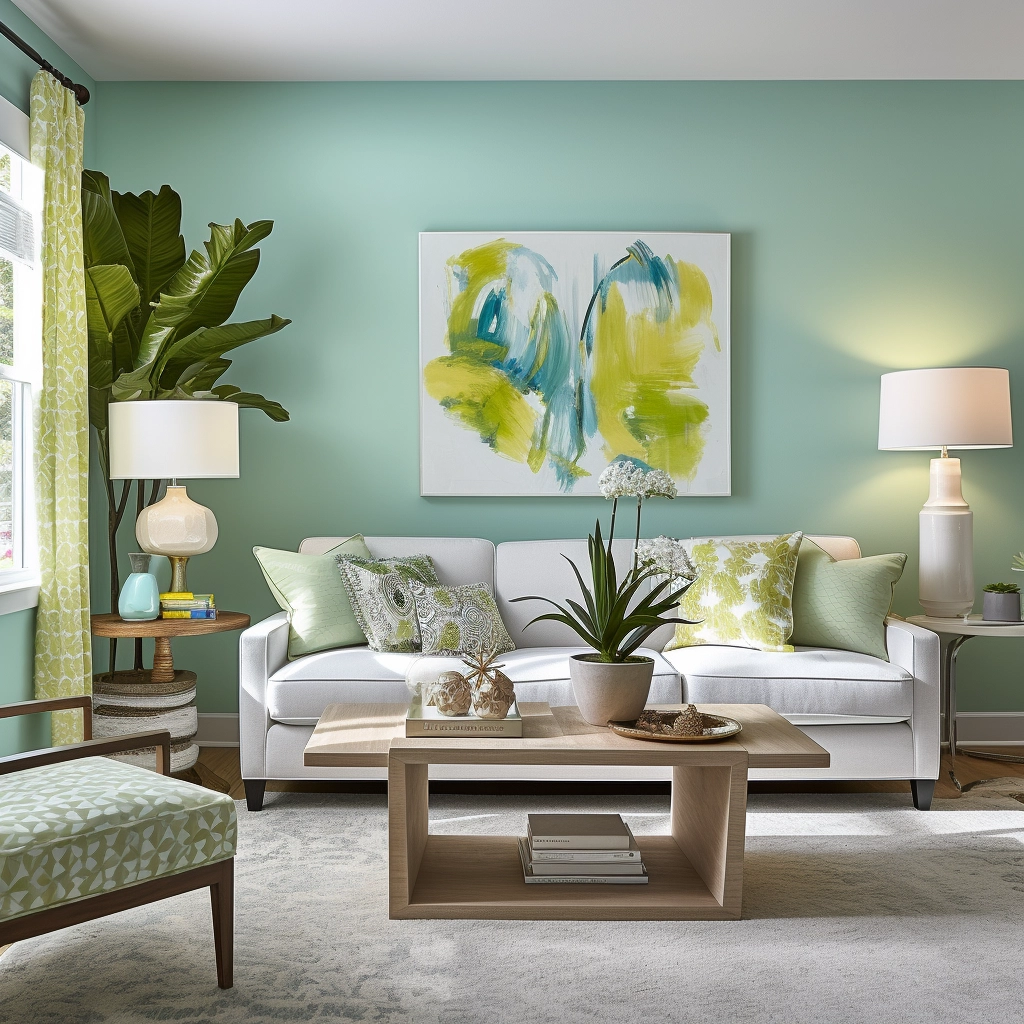
Navy Blue
Navy blue and light blue can offer a timeless monochromatic appeal to your space.
The main appeal is to create depth by layering the blue shades together.
It can create a soothing palette for the eyes as you enter the room.
Navy blue features like furniture, blankets, kitchen cabinets, or vases are ideal examples to pair with your light blue walls.
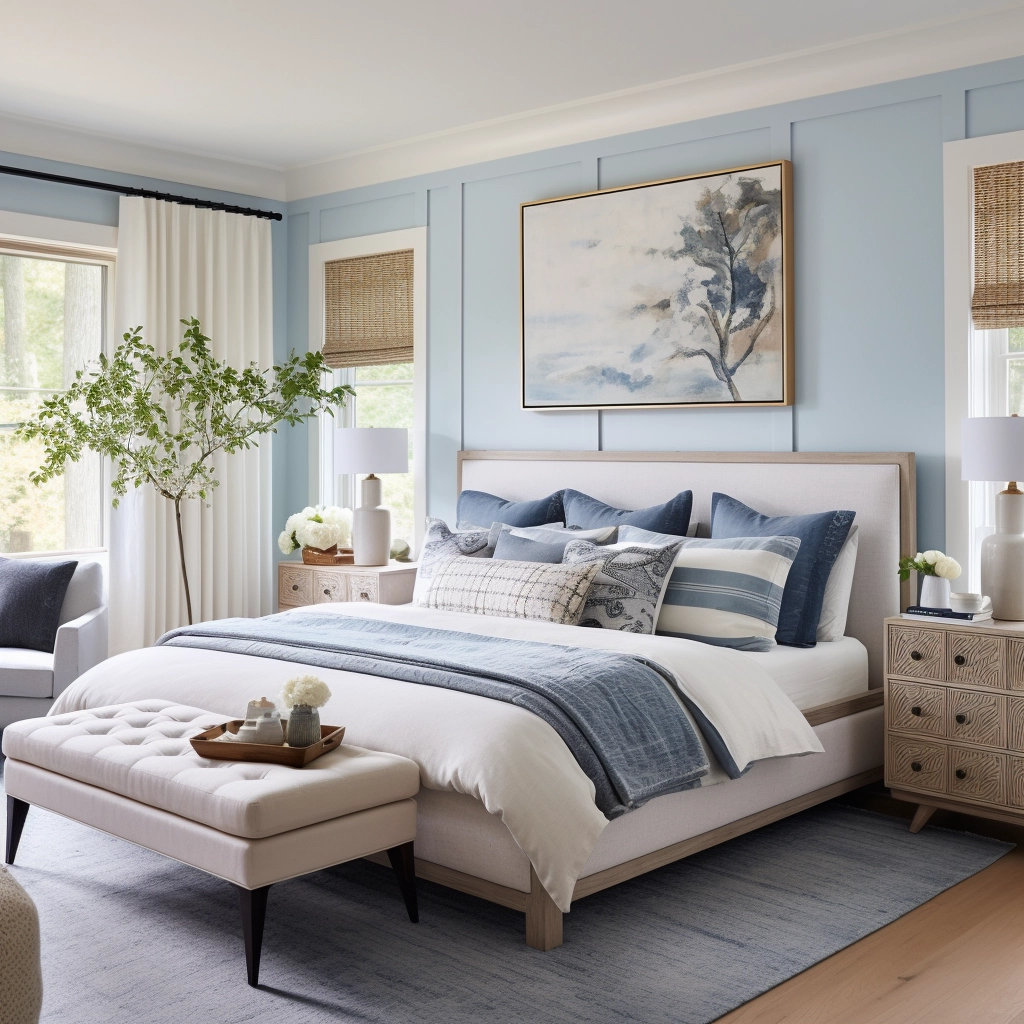
Brown
Adding brown to light blue walls creates a seamless and complementary variation. The tones work ideally together, infusing elegance and sumptuousness in any room.
It’ll provide a lavish appeal if you place the combination in a kitchen, especially paired with marble countertops.
Brown leather furniture will also go flawlessly well with the light blue backdrop.
You can incorporate dark brown wooden elements, like coffee tables or chairs, to provide a refined and luxurious aesthetic in your living room area.
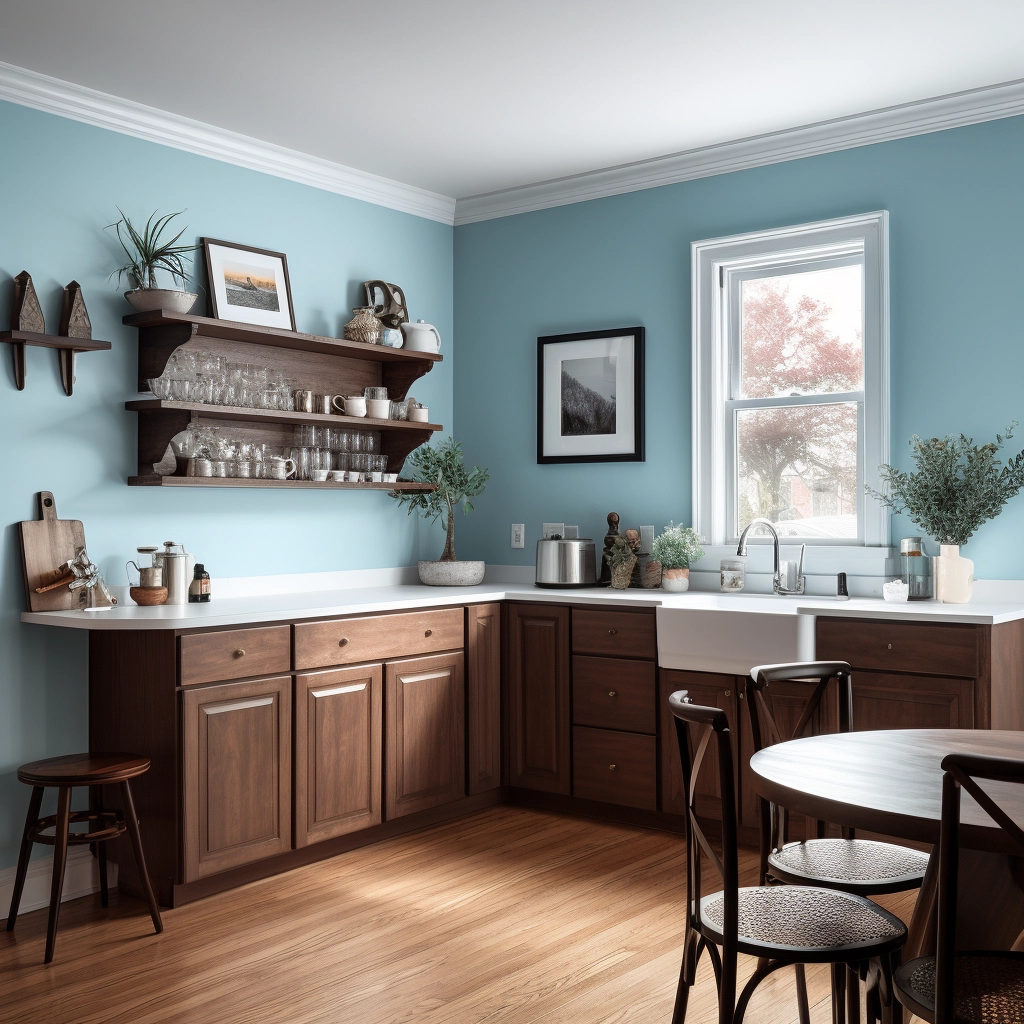
Beige
Beige combines the benefits of adding a neutral and brown shade.
It adds warmth, depth, and contrast, accentuating the blue walls.
A light blue backdrop with beige elements, like a couch, vase, rug, or curtains, creates an opulent appearance.
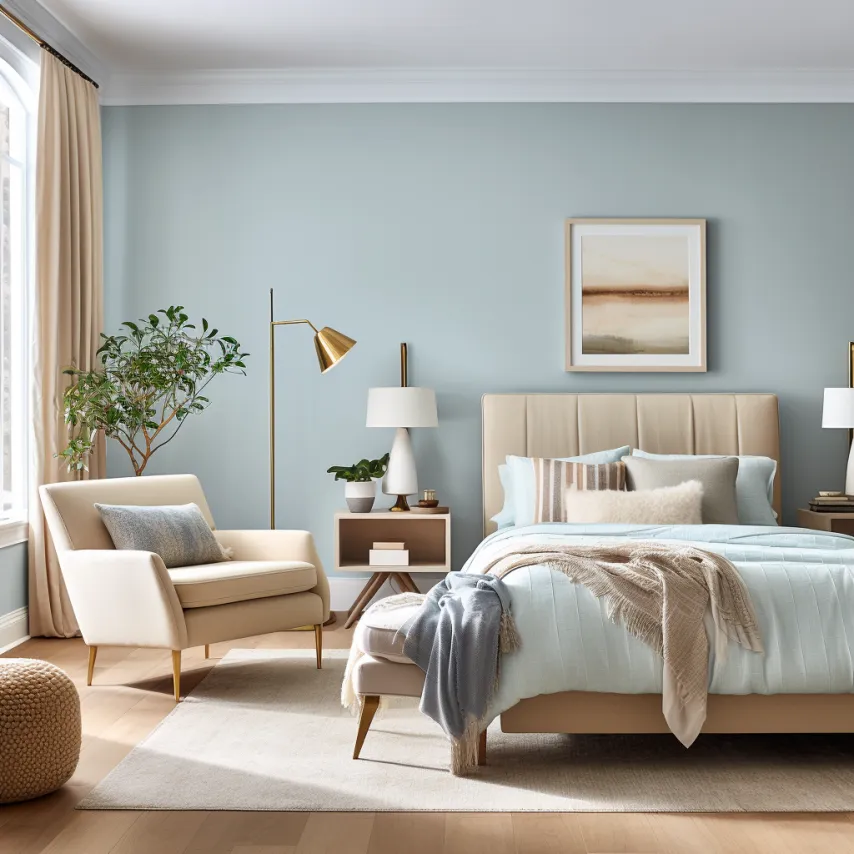
Taupe
Taupe is slightly different from beige because it has more of a gray undertone rather than yellow.
And so, it’s more muted and subtle, giving you more opportunity to play around with other vibrant colors like gold or copper.
Besides that, you can add several taupe elements to a light blue-walled room, like kitchen cabinets, curtains, and furniture.
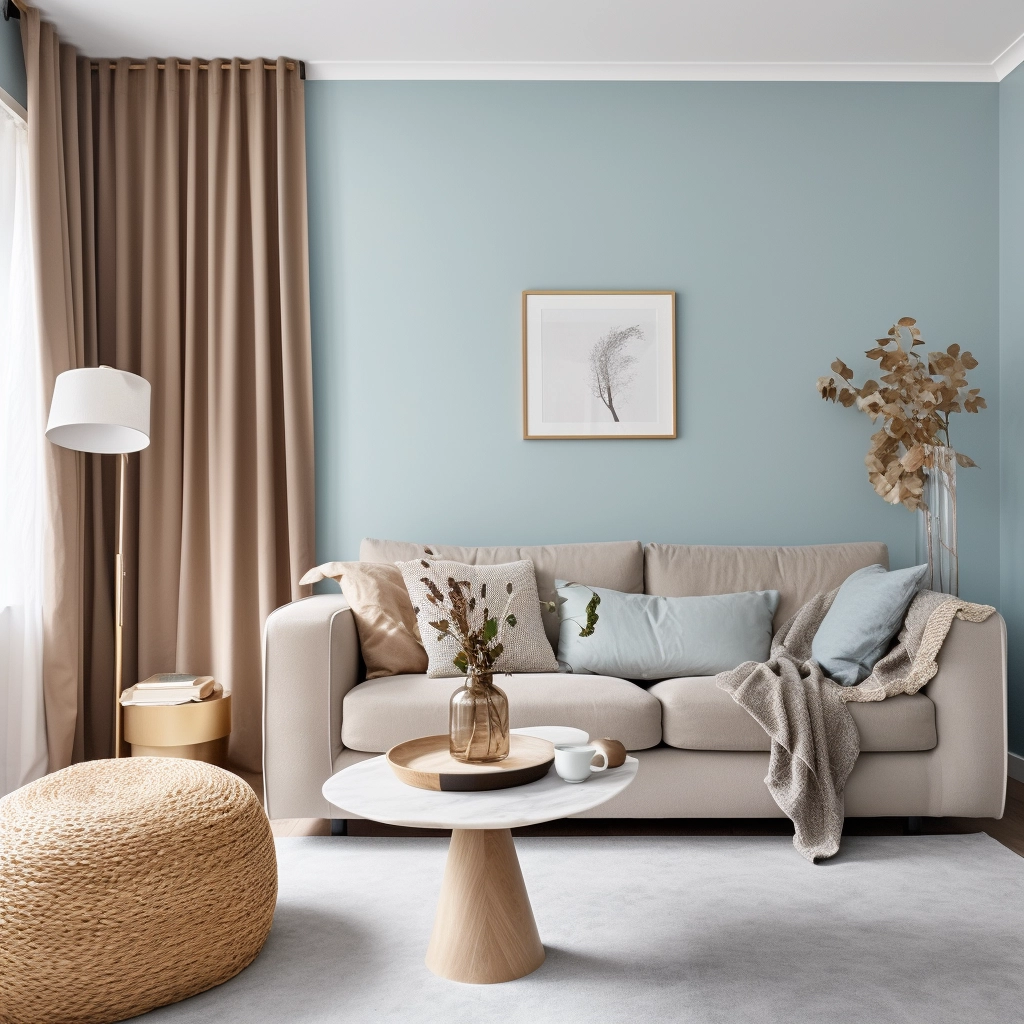
Before you go...
What accent colors go with light blue walls? Well, the choices are endless, from refined navy blue or dark green to neutral gray or cream options.
The color pairing you choose can change the room’s atmosphere.
A muted shade like blush pink can enforce a relaxing ambiance, while a more intense red or black can create a more powerful impact.
Either way, choosing the right color can often be challenging. We recommend checking out our free Paint Color Planning guide to help you make the best on-trend and complementary choices for your next home renovation projects.
Still unsure which paint color is right for your space?
Choosing paint doesn’t have to be stressful! My free Paint Color Planning Quick Start Guide walks you through the exact steps to confidently choose the perfect color — without the overwhelm, second-guessing, or endless swatch testing.
👉 Click here to download the free guide!

My Paint Color Formula course walks you through the painless process of expertly testing paint swatches to ensure you have the perfect color for your home.
The best way to sample paint? Samplize!
Get peel-and-stick removable and reusable paint samples here!
Thanks for reading!
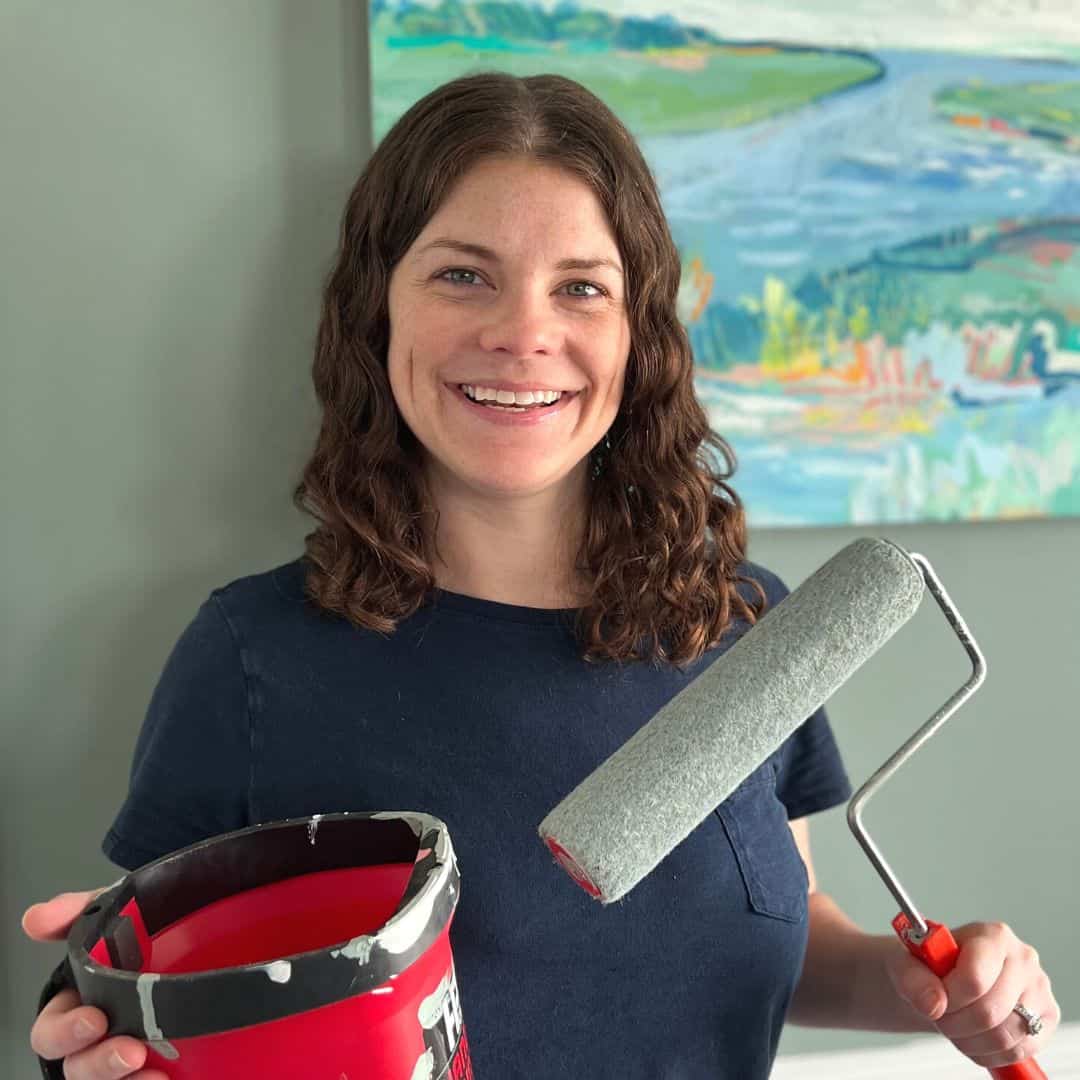
Morgan is passionate about home decor and paint colors. She has been sharing DIY home decor tips since 2012 at CharlestonCrafted.com. From there, she learned to love paint colors, and the Paint Color Project was born in 2022!

